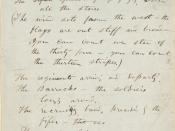Walt Whitman
In parting with traditional poetic formalities, Walt Whitman alleviated a burden that impeded his ability to achieve full poetic expression. To Whitman, the strict boundaries that formal meter, structure, and rhyme imposed set limits on his stylistic freedom. This is not to say that these limits prevented Whitman from conveying his themes. Rather, they presented a contradiction to which Whitman refused to conform. In Whitman's eyes, to meet these formal guidelines one would also have to sacrifice the ability to express qualities and passion of living men. Thus, Whitman contested traditional poetic protocol because it added a layer of superficiality that concerned itself with creating perfect rhythmical, metrical, and structural poetry. It was this end that bothered Whitman, for he believed that each word in a poem should serve only one purpose: "to harmonize with the name, nature, and drift of the poem". To understand exactly what characteristics of traditional poetic rules posed such problems for Whitman, we must establish a working definition of what this means.
Traditional poetic rules are those determined through the history of British poetry . This statement in itself leaves much latitude for interpretation. For the sake of comparison, generalizations must be made. First of all, traditional British poetry adhered to a specific meter, a common example being the iambic foot (unstressed syllable followed by a stressed syllable). Whatever the chosen meter, these patterns were more or less consistent throughout the course of the poem. Similarly, in a traditional British poem, it was desired that each of the lines have the same amount of feet (for example the Shakespearean sonnet written in iambic pentameter, meaning five feet or iambs). Along these same lines, traditional poets valued a concise and logical structure. This meant that stanzas consisted of a predetermined amount of lines or...


